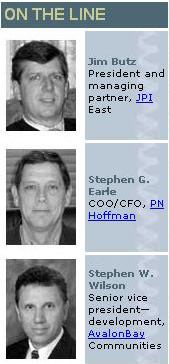EARLE: There’s been discussion in Washington, D.C., about inclusionary zoning, but there’s nothing formal in place other than [the deals you make to get approvals]. We look for properties where we feel we can add significant square footage by engaging the community. If we’re going to gain additional square footage, we will put a share of that aside and offer it as affordable housing as an incentive for the community to support our proposal.
How often do they accept that? EARLE: Very often. We’ve bought a number of sites from D.C. government, and as part of their selection process they mandate a certain amount of affordable housing. The result is that the purchase price you pay for the property is adjusted for providing that product type. … We’re also providing 12 units [of affordable housing] in our Union Square project and three in Chase Point, so it’s different from project to project. It will probably become more standardized in the future.
Do you have an informal threshold on what percentage of affordable housing you’ll accept? EARLE: We don’t. Each community is different [and has its own ideas about] what priorities or amenities they would prefer. … At Union Square, our affordable housing commitment represented 25 percent of the increased density obtained through the rezoning process.
BUTZ: I think that’s one of the biggest questions the industry and the economy face. Affordable housing is a challenge in every market we do business in, and it’s necessary to provide it in major metropolitan areas, or employment growth will stumble. … Most places have some sort of affordable zoning, at least for garden-style or high-density stick-built product. High-rise continues to be the challenge, given the construction hard costs. … It’s difficult to justify putting a person who’s paying 50 percent of the rent into a building and be able to cover your costs. … [One solution I see is when] the local government … uses tax abatements and waivers for development, water, and sewer fees to lower costs so that affordable housing can be generated. Affordable housing is not an issue just for builders. It should be an issue for everybody.
How much of a gamble are you willing to take on a neighborhood? EARLE: I think you have to have vision and confidence in your product and the effectiveness of your program to reach out and engage a city neighborhood. … We have been on the cutting edge of doing business in transitional neighborhoods, and it’s worked.
WILSON: A good example for us is Mission Bay in San Francisco. When we opened in late 2002, we were the first market-rate multifamily project, and combined with the economic melt-down that struck the Bay Area, we were probably a little ahead of ourselves. Now there’s a lot more infrastructure in the neighborhood. Grocery stores have opened, there’s retail in the area, so although we suffered early on, we’re extremely excited and pleased with where we are, and we’re [sharing our commitment to the neighborhood] by breaking ground on another 313-unit community. We were ahead of ourselves for awhile, but if you don’t have that vision or commitment, by the time you do get in, it’s probably too late.
